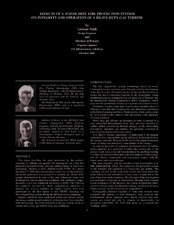| dc.contributor.other | Turbomachinery Symposium (35th : 2006) | |
| dc.creator | Naldi, Lorenzo | |
| dc.creator | D'Ercole, Michele | |
| dc.date.accessioned | 2017-10-04T22:49:13Z | |
| dc.date.available | 2017-10-04T22:49:13Z | |
| dc.date.issued | 2006 | |
| dc.identifier.uri | https://hdl.handle.net/1969.1/163215 | |
| dc.description | Lecture | en |
| dc.description | Pg. 73-80 | en |
| dc.description.abstract | This paper describes the steps performed by the authors’ company to validate and qualify the introduction of a new fire protection system for heavy-duty gas turbines based on water mist technology. Initially, a finite element model (FEM) of a newly developed 32 MW-class industrial gas turbine for mechanical drive and power generation was generated to simulate gas turbine (GT) casings deformations in case of fire and subsequent water mist discharge for various operating conditions and ventilation setups. Secondly, a test was conducted according to NFPA 750 (2003) at the supplier’s facility to check extinguishing efficiency; a mockup was used to simulate the engine. Finally, test were performed on the first engine to test (FETT) operating the fire-extinguishing system during the full load testing campaign. Engine conditions were replicated within and outside normal operating conditions and analytical predictions have been matched with the test data. A extrapolation from the gas turbine results to various heavy-duty gas turbine sizes was conducted. | en |
| dc.format.medium | Electronic | en |
| dc.format.mimetype | application/pdf | |
| dc.language.iso | en | |
| dc.publisher | Texas A&M University. Turbomachinery Laboratories | |
| dc.relation.ispartof | Proceedings of the 35th Turbomachinery Symposium | en |
| dc.subject.lcsh | Turbomachines | en |
| dc.title | Effects Of A Water-Mist Fire Protection System On Integrity And Operation Of A Heavy-Duty Gas Turbine. | en |
| dc.type.genre | Presentation | en |
| dc.type.material | Text | en |
| dc.identifier.doi | https://doi.org/10.21423/R15M1D | |


